
60 Easy Science Experiments Using Materials You Already Have On Hand
- Subject:
- Chemistry
- Physical Science
- Physics
- Material Type:
- Activity/Lab
- Author:
- Jill Staake
- Posted Jill Staake
- Date Added:
- 02/01/2023

60 Easy Science Experiments Using Materials You Already Have On Hand

Students will use engineering skills to develop and use models as well as collaboratively plan an investigation to make sense of buoyancy.
Remix this template to upload your ACP lesson and unit plans into WISELearn.
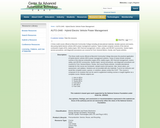
This three credit course offered at Macomb Community College discusses the practical application of hybrid electric vehicle (HEV) power management systems. Areas of study include computer controls of the internal combustion engine (ICE), battery types, HEV thermal management, motors, safety, and HEV/EV accessories. System types, service procedures, and diagnostic procedures are covered for Ford, General Motors, Honda, and Lexus/Toyota vehicles. Included educational materials for this course are homework, sample exams and quizzes, labs, lesson plans, pre-assessment, and syllabus. Solutions are not provided with any materials. If you're an instructor and would like complete exams, quizzes, or solutions, please contact theCAAT. This course is composed of six modules that can be used to supplement existing courses or taught together as a complete course. These modules are Intro to HEVs,Honda HEVs, Toyota HEVs,Ford HEVs, GM HEVs, and Fuel Cells

At this point in the unit, students have learned about Pascal's law, Archimedes' principle, Bernoulli's principle, and why above-ground storage tanks are of major concern in the Houston Ship Channel and other coastal areas. In this culminating activity, student groups act as engineering design teams to derive equations to determine the stability of specific above-ground storage tank scenarios with given tank specifications and liquid contents. With their floatation analyses completed and the stability determined, students analyze the tank stability in specific storm conditions. Then, teams are challenged to come up with improved storage tank designs to make them less vulnerable to uplift, displacement and buckling in storm conditions. Teams present their analyses and design ideas in short class presentations.
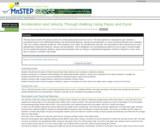
Using students' step length to understand the relationship between distance, speed and acceleration. Includes graphing of data and interpretation of graphs.
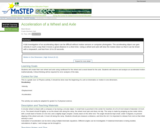
Students make a wheel and axle out of cardboard and a wooden dowel. It is rooled along a ramp made of parallel meter sticks, and the acceleration can be made small enough to make accurate measurements and calculations.

Students work as physicists to understand centripetal acceleration concepts. They also learn about a good robot design and the accelerometer sensor. They also learn about the relationship between centripetal acceleration and centripetal force governed by the radius between the motor and accelerometer and the amount of mass at the end of the robot's arm. Students graph and analyze data collected from an accelerometer, and learn to design robots with proper weight distribution across the robot for their robotic arms. Upon using a data logging program, they view their own data collected during the activity. By activity end , students understand how a change in radius or mass can affect the data obtained from the accelerometer through the plots generated from the data logging program. More specifically, students learn about the accuracy and precision of the accelerometer measurements from numerous trials.
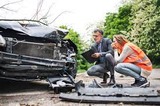
An accident reconstructionist uses multiple variables to determine a vehicles speed at impact during an accident. This activity investigates those variables and uses them to determine the speed of a vehcile during an accident.
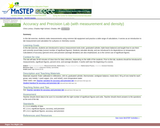
In this lab exercise, students practice correctly using measurement tools, recording data, calculating density, using significant figures, and exploring the concepts of accuracy and precision.
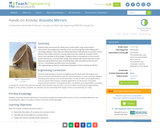
Students play and record the “Mary Had a Little Lamb” song using musical instruments and analyze the intensity of the sound using free audio editing and recording software. Then they use hollow Styrofoam half-spheres as acoustic mirrors (devices that reflect and focus sound), determine the radius of curvature of the mirror and calculate its focal length. Students place a microphone at the acoustic mirror focal point, re-record their songs, and compare the sound intensity on plot spectrums generated from their recordings both with and without the acoustic mirrors. A worksheet and KWL chart are provided.

Students construct rockets from balloons propelled along a guide string. They use this model to learn about Newton's three laws of motion, examining the effect of different forces on the motion of the rocket.

This resource folder provides an adaptation to two units in the OpenSciEd Curriculum: P.1 Energy Flow from Earth's Systems and P.5 Electromagnetic Rdition. Included is a varation on the student workbook that allows more space for student work to be completed, and embeds readings and activites. Also included in the folder are teacher resources pages that keep all important ideas, links, and other resources handy for each lesson. Materials created by OpenSciEd are shareable under a Creative Commons Attribution-NonCommercial-ShareAlike 4.0 International (CC BY-NC-SA 4.0) license. More information can be found at: https://www.openscied.org/openscied-terms-of-use-and-privacy-policies/

In this lab-based activity the students will use their knowledge about the law of conservation of energy to explain the loss of heat by warm water to cold water. Then, the students will use these concepts to design and carry an experiment to determine the unknown temperature of a hot water sample.

In this lesson, students learn about work as defined by physical science and see that work is made easier through the use of simple machines. Already encountering simple machines everyday, students will be alerted to their widespread uses in everyday life. This lesson serves as the starting point for the Simple Machines Unit.

This book is written for anybody who is curious about nature and motion. Curiosity about how people, animals, things, images and space move leads to many adventures. This volume presents the best of them in the domain of everyday life.
Carefully observing everyday motion allows us to deduce six essential statements: everyday motion is continuous, conserved, relative, reversible, mirror-invariant – and lazy. Yes, nature is indeed lazy: in every motion, it minimizes change. This text explores how these six results are deduced and how they fit with all those observations that seem to contradict them. In the structure of modern physics, shown in Figure 1, the results on everyday motion form the major part of the starting point at the bottom. The present volume is the first of a six-volume overview of physics. It resulted from a threefold aim I have pursued since 1990: to present motion in a way that is simple, up to date and captivating.
In order to be simple, the text focuses on concepts, while keeping mathematics to the necessary minimum. Understanding the concepts of physics is given precedence over using formulae in calculations. The whole text is within the reach of an undergraduate.
In order to be up to date, the text is enriched by the many gems – both theoretical and empirical – that are scattered throughout the scientific literature.
In order to be captivating, the text tries to startle the reader as much as possible. Reading a book on general physics should be like going to a magic show. We watch, we are astonished, we do not believe our eyes, we think, and finally we understand the trick. When we look at nature, we often have the same experience. Indeed, every page presents at least one surprise or provocation for the reader to think about. Numerous interesting challenges are proposed.
The motto of the text, die Menschen stärken, die Sachen klären, a famous statement by Hartmut von Hentig on pedagogy, translates as: ‘To fortify people, to clarify things.’ Clarifying things – and adhering only to the truth – requires courage, as changing the habits of thought produces fear, often hidden by anger. But by overcoming our fears we grow in strength. And we experience intense and beautiful emotions. All great adventures in life allow this, and exploring motion is one of them. Enjoy it!

This book is written for anybody who is curious about nature and motion. Curiosity about how people, animals, things, images and empty space move leads to many adven- tures. This volume presents the best of them in the domains of relativity and cosmology. In the study of motion – physics – special and general relativity form two important building blocks.
Special relativity is the exploration of the energy speed limit c. General relativity is the exploration of the force limit c4/4G. The text shows that in both domains, all equations follow from these two limit values. This simple, intuitive and unusual way of learning relativity should reward the curiosity of every reader – whether student or professional.
The present volume is the second of a six-volume overview of physics that arose from a threefold aim that I have pursued since 1990: to present motion in a way that is simple, up to date and captivating.
In order to be simple, the text focuses on concepts, while keeping mathematics to the necessary minimum. Understanding the concepts of physics is given precedence over using formulae in calculations. The whole text is within the reach of an undergraduate.
In order to be up to date, the text is enriched by the many gems – both theoretical and empirical – that are scattered throughout the scientific literature.
In order to be captivating, the text tries to startle the reader as much as possible. Read- ing a book on general physics should be like going to a magic show. We watch, we are astonished, we do not believe our eyes, we think, and finally we understand the trick. When we look at nature, we often have the same experience. Indeed, every page presents at least one surprise or provocation for the reader to think about. Numerous interesting challenges are proposed.
The motto of the text, die Menschen stärken, die Sachen klären, a famous statement by Hartmut von Hentig on pedagogy, translates as: ‘To fortify people, to clarify things.’ Clar- ifying things – and adhering only to the truth – requires courage, as changing the habits of thought produces fear, often hidden by anger. But by overcoming our fears we grow in strength. And we experience intense and beautiful emotions. All great adventures in life allow this, and exploring motion is one of them. Enjoy it!

This book is written for anybody who is curious about nature and motion. Curiosity about how people, animals, things, images and empty space move leads to many adventures. This volume presents the best of them in the domains of relativity and cosmology. In the study of motion – physics – special and general relativity form two important building blocks.

This book is written for anybody who is curious about nature and motion. Have you ever asked: Why do people, animals, things, images and space move? The answer leads to many adventures; this volume presents those due to the discovery that there is a smallest change value in nature. This smallest change value, the quantum of action, leads to what is called quantum physics. In the structure of modern physics, quantum physics covers three points; this volume covers the introduction to the point in the lower right: the foundations of quantum theory.
The present introduction to quantum physics arose from a threefold aim I have pur- sued since 1990: to present the basics of motion in a way that is simple, up to date and captivating.
In order to be simple, the text focuses on concepts, while keeping mathematics to the necessary minimum. Understanding the concepts of physics is given precedence over using formulae in calculations. The whole text is within the reach of an undergraduate.
In order to be up to date, the text is enriched by the many gems – both theoretical and empirical – that are scattered throughout the scientific literature.
In order to be captivating, the text tries to startle the reader as much as possible. Read- ing a book on general physics should be like going to a magic show. We watch, we are astonished, we do not believe our eyes, we think, and finally we understand the trick. When we look at nature, we often have the same experience. Indeed, every page presents at least one surprise or provocation for the reader to think about. Numerous interesting challenges are proposed.
The motto of the text, die Menschen stärken, die Sachen klären, a famous statement by Hartmut von Hentig on pedagogy, translates as: ‘To fortify people, to clarify things.’ Clar- ifying things – and adhering only to the truth – requires courage, as changing the habits of thought produces fear, often hidden by anger. But by overcoming our fears we grow in strength. And we experience intense and beautiful emotions. All great adventures in life allow this, and exploring motion is one of them. Enjoy it!

This book is written for anybody who is intensely curious about nature and motion. Have you ever asked: Why do people, animals, things, images and empty space move? The answer leads to many adventures, and this book presents one of the best of them: the search for a precise, unified and final description of all motion.
The wish to describe all motion is a large endeavour. Fortunately, this large endeavour can be structured in the simple diagram shown in Figure 1. The final and unified description of motion, the topic of this book, corresponds to the highest point in the diagram. Searching for this final and unified description is an old quest. In the following, I briefly summarize its history and then present an intriguing, though speculative solution to the riddle.
The search for the final, unified description of motion is a story of many surprises. For example, twentieth-century research has shown that there is a smallest distance in nature. Research has also shown that matter cannot be distinguished from empty space at those small distances. A last surprise dates from this century: particles and space are best described as made of strands, instead of little spheres or points. The present text explains how to reach these unexpected conclusions. In particular, quantum field theory, the standard model of particle physics, general relativity and cosmology are shown to follow from strands. The three gauge interactions, the three particle generations and the three dimensions of space turn out to be due to strands. In fact, all the open questions of twentieth-century physics about the foundations of motion, all the millennium issues, can be solved with the help of strands.
The strand model, as presented in this text, is an unexpected result from a threefold aim that I have pursued since 1990, in the five previous volumes of this series: to present the basics of motion in a way that is up to date, captivating and simple. In retrospect, the aim for maximum simplicity has been central in deducing this speculation. While the previous volumes introduced, in an entertaining way, the established parts of physics, this volume presents, in the same entertaining and playful way, a speculation about unification. Nothing in this volume is established knowledge – yet. The text is the original presentation of the topic.
The search for a final theory is one of the great adventures of life: it leads to the limits of thought. The search overthrows our thinking habits about nature. A change in thinking habits can produce fear, often hidden by anger. But by overcoming our fears we gain strength and serenity. Changing thinking habits thus requires courage, but it also produces intense and beautiful emotions. Enjoy them!

This book is written for anybody who is curious about nature and motion. Curiosity about how bodies, images and empty space move leads to many adventures. This volume presents the best adventures about the motion inside people, inside animals, and inside any other type of matter – from the largest stars to the smallest nuclei.
Motion inside bodies – dead or alive – is described by quantum theory. Quantum theory describes all motion with the quantum of action h, the smallest change observed in nature. Building on this basic idea, the text first shows how to describe life, death and pleasure. Then, the text explains the observations of chemistry, materials science, astrophysics and particle physics. In the structure of physics, these topics correspond to the three ‘quantum’ points in Figure 1. The story of motion inside living and non-living matter, from the coldest gases to the hottest stars, is told here in a way that is simple, up to date and captivating.
In order to be simple, the text focuses on concepts, while keeping mathematics to the necessary minimum. Understanding the concepts of physics is given precedence over using formulae in calculations. The whole text is within the reach of an undergraduate.
In order to be up to date, the text is enriched by the many gems – both theoretical and empirical – that are scattered throughout the scientific literature.
In order to be captivating, the text tries to startle the reader as much as possible. Read- ing a book on physics should be like going to a magic show. We watch, we are astonished, we do not believe our eyes, we think, and finally we understand the trick. When we look at nature, we often have the same experience. Indeed, every page presents at least one sur- prise that makes the reader think. Also numerous interesting challenges are proposed.
The motto of the text, die Menschen stärken, die Sachen klären, a famous statement by Hartmut von Hentig on pedagogy, translates as: ‘To fortify people, to clarify things.’ Clar- ifying things – and adhering only to the truth – requires courage, as changing the habits of thought produces fear, often hidden by anger. But by overcoming our fears we grow in strength. And we experience intense and beautiful emotions. All great adventures in life allow this, and exploring motion is one of them. Enjoy it!